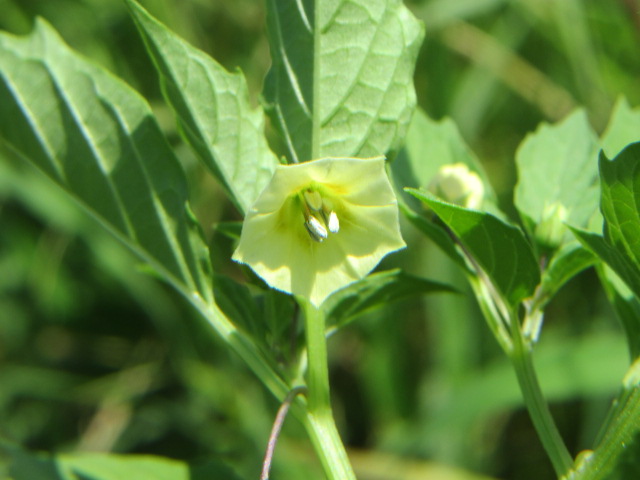
Brugmansia sp. on 10-23-09, #42-5.
Solanaceae Juss.
so-lan-AY-see-ee
OR
so-lan-AY-see-eye
The plant family Solanaceae was named and described by Antoine Laurent de Jussieu in Genera Plantarum in 1789.
As of 12-29-23 when this page was last updated, Plants of the World Online lists 101 genera in this family commonly known as the nightshade family.
Members of this family include annuals, perennials, vines, lianas, epiphytes, trees, and shrubs. It includes a number of vegetables, herbs, spices, weeds, and highly toxic plants.
Some of our favorite vegetables are in this genera including tomatoes, potatoes, eggplant, and peppers. Tobacco is also in this family.
Besides growing tomatoes, potatoes, eggplant, and peppers, I have grown Brugmansia and Datura. I have identified several wildflowers in this family growing on my farm that are quite common. You can click on the plant names under the photos to go to their own pages.
For more information about this family of plants, click on the links below. The links take you directly to the information about the family.
PLANTS OF THE WORLD ONLINE
WIKIPEDIA
SOLANACEAE SOURCE
BRITANNICA

Brugmansia on 8-21-09, #28-3.
When I lived in Mississippi for a few years I was able to grow quite a few plants I hadn’t grown before. Among them were several species of Brugmansia. In the evening, the scent of the flowers would fill the air.
<<<<+>>>>

Datura innoxia (Moon Flower) on 9-6-12, #118-3.
I good friend and fellow plant collector gave me a Datura innoxia (Moon Flower) in 2012 when I lived in Mississippi. It was quite interesting…
<<<<+>>>>

Datura metal flower on 9-23-10, #60-12
I grew three Datura metel (Purple Datura) from seed in 2009 while living in Mississippi. I gave them to a friend when I moved back to Missouri in 2013.
<<<<+>>>>

Datura stramonium (Jimson Weed) on 5-28-15, #264-2.
Well, there are plenty of Datura stramonium (Jimsonweed) on the farm next to the pond behind the barn. They have mainly stayed in the same area. Common names include Jimson Weed, Loco Weed, Devil’s Snare, Devil’s Trumpet, Thorn Apple, Tolguacha, Jamestown Weed, Stinkweed, Pricklyburr, Devil’s Cucumber, Hell’s Bells, and possibly others.
<<<<+>>>>

Physalis angulata (Cutleaf Groundcherry) on 9-3-22, #909-2.
I found this Physalis angulata (Cutleaf Groundcherry) in an area south of the barn in 2022. It was another “HOLY CRAP” moment.
<<<<+>>>>

Physalis longifolia (Common Ground Cherry) on 7-16-19, #602-22.
So, I ran into this Physalis longifolia (Common Ground Cherry) while working on his farm in 2019. Some of the photos didn’t turn out well and I needed more photos of its leaves. Somehow, I could not find it again… There are two varieties where I live in Missouri, one with narrower leaves and one with broader leaves. I needed to find the plant again to figure out which one I found. Then, in November, I found a plant with “suspicious” seed pods right on my own farm in an area where nothing exciting usually grows… Every year since I scour the area hoping to find one of these plants growing but so far nothing. GEEZ!!! They would be easy to spot because they have yellow flowers and the plant is similar to Horsenettle. Their fruit has a husk around it like a Husk Tomato (Tomatillo)… Since I found a Physalis angulata south of the barn in 2022, I’m wondering if the “suspicious” seed pods are from that species instead of Physalis longifolia…
<<<<+>>>>

Solanum alatum (Black Nightshade) on 9-14-18, #508-2
I spotted a Solanum alatum (Eastern Black Nightshade) on the farm while taking wildflower photos for a post on September 14 in 2018. Strange I had never seen these plants before even though I had been in the spot they were growing many times over the summer. I knew they were Black Nightshade even though I had not seen one in person before. Until I started updating the page on 12-27-23, I thought it was S. americanum. With the help of a few INaturalist members who set me straight, I realized the plant I found was actually Eastern Black Nightshade. Most websites use the species name Solanum ptycanthum which is the incorrect spelling and authorship. Even though the correct spelling is S. ptychanthum, it is a synonym. The most recent scientific name is, or was, Solanum emulans. Ummm… Currently, the accepted scientific name is S. alatum, back where it began in 1794…
<<<<+>>>>

Solanum carolinense (Horsenettle) on 7-17-19, #603-25.
There’s A LOT of Solanum carolinense (Horsenettle) growing on the farm and in every pasture I have been in. Some of the plants have white flowers are some have various shades of light purple. There is definitely no problem finding them because they are everywhere. Common names include Horsenettle, Horse Nettle, Carolina Horsenettle, Bull Nettle, Devil’s Tomato, Sand Briar, and possibly others.
<<<<+>>>>

Flowers on the Solanum pyracanthos (Porcupine Tomato) on 10-21-12, #123-12.
I was browsing plants a seller on Ebay had listed in 2012 and ran across Solanum pyracanthos (Porcupine Tomato). I had never seen anything like that, so I had to order one. It was very interesting… Devil’s Thorn is another common name.
<<<<+>>>>

Solanum rostratum (Buffalo Bur) on 7-24-19, #605-30.
I found a few Solanum rostratum (Buffalo Bur) on the same farm where I found the Solanum longifolia. You wouldn’t want to step on any thorny plant barefooted, but this one’s fruit is also very thorny… GEEZ! It is a pretty neat plant but I am glad I don’t have any on my farm…
<<<<+>>>>

Solanum sarrachoides (Hair Black Nightshade) on 9-10-23, #960-63.
I found this Solanum sarrachoides (Hairy Black Nightshade) along the ditch south of the main pond in the front pasture. It was actually closer to the smaller pond. Anyway, It was a great find for 2023 since the summer had been very hot and dry. Most wildflowers fizzled out by mid-summer. I don’t have a page finished for this species yet…
That’s all I have for this family of plants. You never know what I will run across in the future…